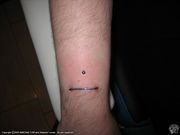Depression and Dermal Anchoring: Difference between pages
(Page conversion via llm-mediawiki-rev -jwm) |
(Page conversion via llm-mediawiki-rev -jwm) |
||
| Line 1: | Line 1: | ||
[[File:Dermalanchor1.jpg|thumb|right|180px]] | |||
[[File:Dermalanchor2.jpg|thumb|right|180px]] | |||
'''Dermal anchoring''' is a technique that is essentially a single-point [[Pocketing|pocketing]]. It gives the appearance of a small single bead on the skin, similar to a [[Transdermal implant|transdermal implant]], but with a much simpler procedure. | |||
It is | The procedure was devised by Ben from House of Color. His technique is explained in a [http://news.bmezine.com/2005/10/14/dermal-anchoring-the-dermal-anchor-piercing-procedure-the-publishers-ring BME interview]. It has found favor with many artists as the technique is simpler and less invasive than a transdermal implant procedure, and the removal of the piece is substantially easier than implant removal. The relative small size of the jewellery allows placement almost anywhere on the body, although healing can be difficult, as with [[Surface piercings|surface piercings]], on areas of high movement or places that get knocked. | ||
This procedure is still very much in its infancy, and since the article, several practitioners have been experimenting with different jewellery designs and insertion techniques. The current most popular method of performing a dermal anchoring is very similar to the [[Punch and taper|punch and taper]] technique for surface piercing. A single hole is made with a small dermal punch, and a taper is used to elevate some of the skin around it to allow for jewellery insertion. | |||
To remove the jewellery, the area around it is massaged, and the piece manipulated gently out. | |||
== | == Related Risks == | ||
[[Rejection|Rejection]] | |||
Latest revision as of 02:26, 17 September 2023
Dermal anchoring is a technique that is essentially a single-point pocketing. It gives the appearance of a small single bead on the skin, similar to a transdermal implant, but with a much simpler procedure.
The procedure was devised by Ben from House of Color. His technique is explained in a BME interview. It has found favor with many artists as the technique is simpler and less invasive than a transdermal implant procedure, and the removal of the piece is substantially easier than implant removal. The relative small size of the jewellery allows placement almost anywhere on the body, although healing can be difficult, as with surface piercings, on areas of high movement or places that get knocked.
This procedure is still very much in its infancy, and since the article, several practitioners have been experimenting with different jewellery designs and insertion techniques. The current most popular method of performing a dermal anchoring is very similar to the punch and taper technique for surface piercing. A single hole is made with a small dermal punch, and a taper is used to elevate some of the skin around it to allow for jewellery insertion.
To remove the jewellery, the area around it is massaged, and the piece manipulated gently out.

